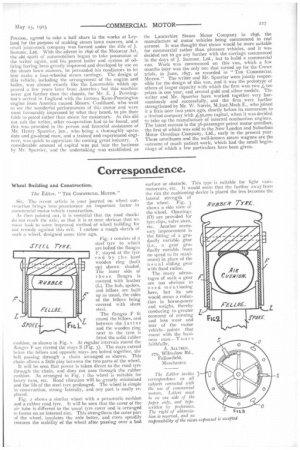Correspondence.
Page 15

If you've noticed an error in this article please click here to report it so we can fix it.
The Editor, "THE COMMERCIAL MOTOR."
Sir, •The recent article in your journal on wheel con-aruction brings into prominence an important factor in commercial motor vehicle construction.
As then pointed out, it is essential that the road shocks do not reach the axle, so that it is at once obvious that we must look to some improved method of wheel building for our remedy against this evil. I enclose a rough sketch of such a wheel, designed some time ago.
Fig. x consists of a steel tyre to which are bolted the flanges F, stayed at the tyre end by the hard wooden ring (built up) shown shaded. The inner side of these flanges is covered with leather (L). The hub, spokes, and felloes are built up as usual, the sides of the felloes being covered with sheet steel.
The flanges F fit round the felloes, and between the latter and the wooden ring next to the tyre is fitted the solid rubber cushion, as shown in Fig. 1. At regular intervals round the flanges F are riveted the stays S (Fig. 3). The stays extend below the felloes and opposite stays are bolted together, the bolt passing through a chain arranged as shown. This chain allows a little play between the two parts of the wheel.
It will be seen that power is taken direct to the road tyre through the chain, and does not pass through the rubber cushion. As arranged in Fig. / the wheel is suitable for heavy vans, etc. Road vibration will be greatly minimised and the life of the steel tyre prolonged. The wheel is simple in construction, strong laterally, and any part is easily replaced.
Fig. 2 shows a similar wheel with a pneumatic cushion and a rubber road tyre. It will be seen that the cover of the air tube is different to the usual tyre cover and is arranged to fasten on an internal rim. This strengthens the outer part of the wheel, insulates the axle better, and more speedily restores the stability of the wheel after passing over a bad
s suitable for light vans, hat the further away from placed the less becomes the surface or obstacle. This type i motorcars, etc. It would seem t the rim the cushioning device is lateral strength of the wheel. Fig. 3 shows a side view of the wheel. Openings (0) are provided for tyre clips, valve stem, etc. Another necessary improvement is the fitting of a gradually variable gear (i.e., a gear gradually variable from no speed to its maximum) in place of the usual sliding gear with fixed ratios.
The many advantages of such a gear are too obvious to need mentioning here, but its use would mean a reduction in horse-power and weight, thereby conducing to greater economy of running and less wear and tear of the motor vehicle— points that count with the business man.—Y You faith fully, A. ALLTREE. 279, Wilmslow Rd.,
Fallowfield, Manchester.
















